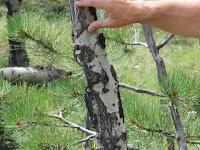When I started at NCSU, neither of the two vertebrate paleontologists were in a good position to take on a new advisee. One had just switched over from the geology department, and the other was new to the school. Then one day, my default adviser mentioned that she had heard that someone next door to her office studied paleo-something. "Or was it archeo... I forget, but anyway..."

Well, it was a long shot, but when I went next door I found myself talking to a paleobotanist and talking not only about classes but about undergraduate research. The first thing that he had me do was read about Florissant, mostly because I was going to be reading about fossils that were a similar age to those I would be working on. The book also talked about the animals that have been found there. The site really caught my interest, and I finally had the chance to stop there on my way home this time.
The geology is super interesting; once upon a time, Colorado had vast redwood forests, like California has today. The elevation of this particular spot used to be higher than it is now. The area wasn't far from the Guffey volcano, which is no longer visible today but was an active conglomerate volcano at the time. It was much like Mt. St. Helens.
 At one point, the activity sent a mud flow roaring down the hill. It slowed down as the hill leveled out, and at the bottom it surrounded the lower 15 feet of the redwoods. Eventually the trees died and the unburied parts rotted away, leaving behind the tree stumps and the upper parts of the roots that hadn't already been in the ground. The wood permineralized, so that the bark and the cell structure was preserved.
At one point, the activity sent a mud flow roaring down the hill. It slowed down as the hill leveled out, and at the bottom it surrounded the lower 15 feet of the redwoods. Eventually the trees died and the unburied parts rotted away, leaving behind the tree stumps and the upper parts of the roots that hadn't already been in the ground. The wood permineralized, so that the bark and the cell structure was preserved.
 The preservation was so perfect that the people who first found it tried to cut into the wood for firewood before they realized (after a couple of saw blades) that they were dealing, basically, with rock. Then, when they tried to saw it up for souvenirs (unfortunately) they lost a couple more saw blades.
The preservation was so perfect that the people who first found it tried to cut into the wood for firewood before they realized (after a couple of saw blades) that they were dealing, basically, with rock. Then, when they tried to saw it up for souvenirs (unfortunately) they lost a couple more saw blades.The redwoods that were preserved included a set of three stumps. We find these today in other places where redwoods still live; when a tree is damaged or dies, it has smaller ones sprout out from the sides, as long as the roots are still alive.
The mudflows blocked up a river and formed a lake, where alternating layers of shale and ash, as well as algae blooms, led to beautiful fossils of leaves, insects, and the occasional vertebrate.


This is one of the only vertebrate fossils found at the site, and the real one can be in the museum in Boulder. It is the jaw of mesohippus, an early relative of the horse. There are also fossils of fish and a bird.

 The site also has some more recent (archaeological) remains of Native Americans. The Utes were in this area, as they were in Utah, not too long ago. Some of the aspen trees are stripped, partially because the bark can be used for a similar way to asprin. In addition, some of the conifers there have been staked down for religious reasons. It was said that the trees that survived being staked down in this way became stronger, and that strength could be derived from them by praying at them. In addition, some of them would be used for direction, staked down to point in given directions toward mountains that were the destinations of pilgrimages that they would take.
The site also has some more recent (archaeological) remains of Native Americans. The Utes were in this area, as they were in Utah, not too long ago. Some of the aspen trees are stripped, partially because the bark can be used for a similar way to asprin. In addition, some of the conifers there have been staked down for religious reasons. It was said that the trees that survived being staked down in this way became stronger, and that strength could be derived from them by praying at them. In addition, some of them would be used for direction, staked down to point in given directions toward mountains that were the destinations of pilgrimages that they would take.Personally, I got more excited about the petrified trees, but the entire side trip was super interesting.









No comments:
Post a Comment